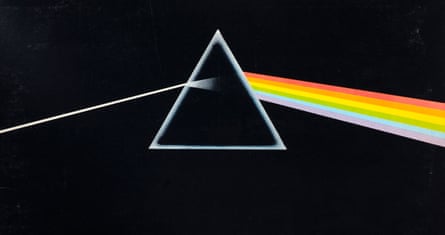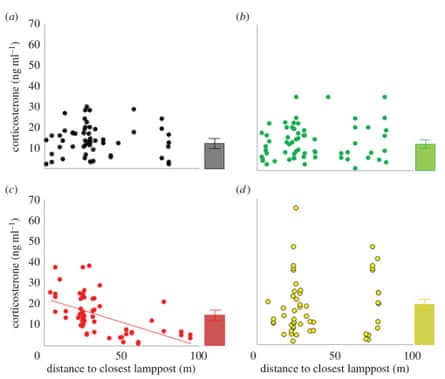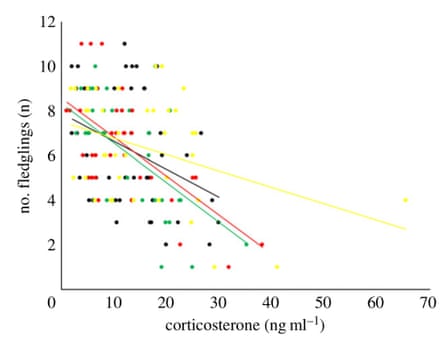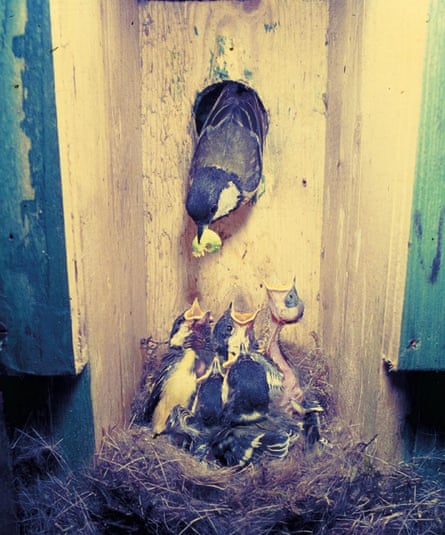A study published today in the journal Biology Letters reports that free-living urban songbirds have increased levels of the stress hormone, corticosterone, in their bloodstream when they nest under street lights. Higher corticosterone concentrations raises the likelihood that birds will prematurely abandon their nests, eggs and chicks. The study, which also investigated the effects of other colours of artificial lighting on wild birds, found that corticosterone levels decrease as nest distance increases from a lamppost with red lighting. This research suggests it may be possible to reduce the disturbing effects of night lighting on wildlife by using street lights with specific colour spectra.
Light pollution is a growing problem for wildlife
“The world is getting increasingly more illuminated at night, and yet there’s so little known about the effects” in wildlife, said one of the study’s co-authors, behavioural ecologist Kamiel Spoelstra, a postdoctoral fellow at the Netherlands Institute of Ecology (NIOO-KNAW).
“Since I was young I’ve been interested in nocturnal animals such as bats, mice and martens and I’ve been out in the forest at night a lot. Apart from the fact that artificial light really disturbs many species of animals [...] artificial light disturbs the night habitat in general and how we ourselves actually experience the night”, said Dr Spoelstra in email.
Research indicates that a variety of wildlife behaviours have been significantly altered by nighttime light pollution. For example, newly hatched sea turtles crawl inland rather than towards the sea; insects waste their short reproductive lives swarming around street lights; songbirds sing earlier in the year; millions of wild birds die by crashing into lighted structures at night, and migrating birds are increasingly getting lost on their seasonal journeys. In short, wildlife doesn’t have to live in or near a city to have their lives disrupted or cut short by city lights.

But white light comprises a rainbow of visible colours of light, or light spectra -- any one of which could have different physiological effects in, say, a bird. There is at least some evidence to support this notion: a letter published in 2000 reports that long wavelength (red) light provides greater photostimulation in a captive songbird than short wavelength (blue) light (Kumar, Rani & Malik). Photostimulation speeds the onset of breeding in birds. This observation raises the question: are all light colour spectra equally stressful to birds?
Some light spectra may be less stressful than others for birds
To gain a better understanding of how different colours (spectral wavelengths) of artificial nighttime lighting affect wild songbirds, an international team of scientists, led by integrative physiologist Jennifer Ouyang, a postdoctoral fellow at the Netherlands Institute of Ecology (NIOO-KNAW), went into the field in the Netherlands in search of answers.
The team of researchers designed a series of experiments where they artificially illuminated eight natural areas from sunset until sunrise. Each site had four transects that were each 100 metres long and contained five lampposts that were 4 metres tall. Each transect was randomly assigned to use either white, red, or green LED lighting or to be a dark “control” treatment. Nine nest boxes, designed especially for great tits, Parus major, were placed along each transect at varying distances from the lampposts.

To measure the concentration of the stress hormone, corticosterone (or “cort”), in the breeding birds’ blood plasma, the adults were captured in their nest boxes when their chicks were between 10 and 12 days old. A small sample of blood was collected within three minutes of capture and placed on ice before plasma was separated out and the plasma cort levels were measured in the lab.
The researchers found a significant effect of the light colour treatment and the interaction of treatment and distance to the closest lamppost on the parent birds’ plasma cort levels (Figure 1):

Basically, the research team found that individual songbirds nesting under white light (Figure 1d) had higher corticosterone levels than individuals nesting under green light (Figure 1b) or under darkness (Figure 1a). They also found that birds nesting closer to a red lamppost had higher cort levels than those nesting farther away (Figure 1c), which was similar to their findings for the white light treatment (Figure 1d) -- and different from the effect of distance for both the darkness (Figure 1a) and green light treatments (Figure 1b). Additionally, since the effect of red light diminishes more quickly as nest box distance from the light source increases, the research team suggests that birds may perceive red light as being less intense than other colours.
Interestingly, the magnitude of the increase in cort levels for free-living songbirds nesting under white light is similar to the response measured for laboratory rats (Scheving & Pauly, 1966) -- although the lab rats were captive domesticated animals that could not escape the lights.
The team also found that whether the parent birds managed to successfully fledge at least one chick was not related to their corticosterone levels, nor to the light treatment they were exposed to, nor to the distance between the nest box and the lamppost. But when the team excluded all failed broods from their analysis, they found that adults with higher cort levels fledged fewer offspring than those with lower cort (Figure 2):

City planners could use light spectra that are least disruptive to wildlife
“As artificial night light increases across the globe, government agencies, conservationists and scientists are all looking for ways to minimize the impact of light pollution”, said Dr Ouyang in email.
These data suggest that different light colour spectra might have distinct physiological effects upon wildlife -- but the challenge lies in identifying which spectra are least disturbing.
“Birds nesting in white light have high corticosterone levels, at the level of individuals undergoing a capture and restrain stress. Using different light colors, such as red or green light, might minimize the physiological impact from artificial light at night”, explained Dr Ouyang.
Of course, humans are animals too, so using different colours for city street lights may also affect people. For example, “[i]n humans, blue light suppresses melatonin (the hormone that regulates circadian rhythms) more than other light colors”, said Dr Ouyang.
This study, the first of its kind, shows that light pollution increases stress hormone concentrations in free-living songbirds. It also suggests that different light spectra may affect physiology differently, thus, using different spectra for street lights may potentially reduce the disturbances caused by light pollution to free-living wildlife.

Source:
Jenny Q. Ouyang, Maaike de Jong, Michaela Hau, Marcel E. Visser, Roy H. A. van Grunsven and Kamiel Spoelstra (2015). Stressful colours: corticosterone concentrations in a free-living songbird vary with the spectral composition of experimental illumination, Biology Letters, published online on 26 August 2015 ahead of print | doi:10.1098/rsbl.2015.0517 (OA)
Also cited:
Vinod Kumar, Sangeeta Rani and Shalie Malik (2000). Wavelength of light mimics the effects of the duration and intensity of a long photoperiod in stimulation of gonadal responses in the male blackheaded bunting (Emberiza melanocephala), Current Science 79(4):508-510 (OA)
LE Scheving & JE Pauly (1966). Effect of light on corticosterone levels in plasma of rats, American Journal of Physiology 210(5):1112-7 [£]
.. .. .. .. .. .. .. .. .. .. ..
GrrlScientist is very active on twitter @GrrlScientist

Comments (…)
Sign in or create your Guardian account to join the discussion